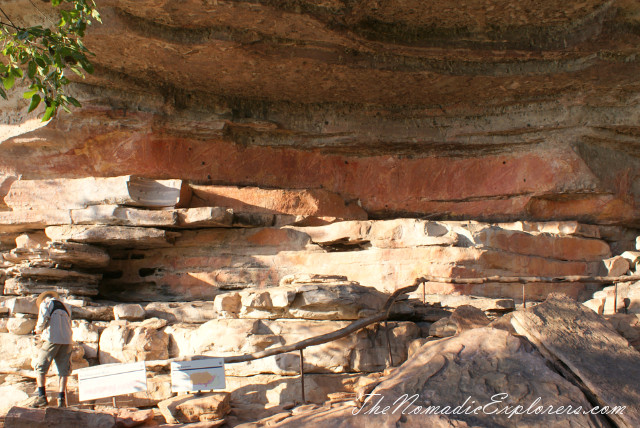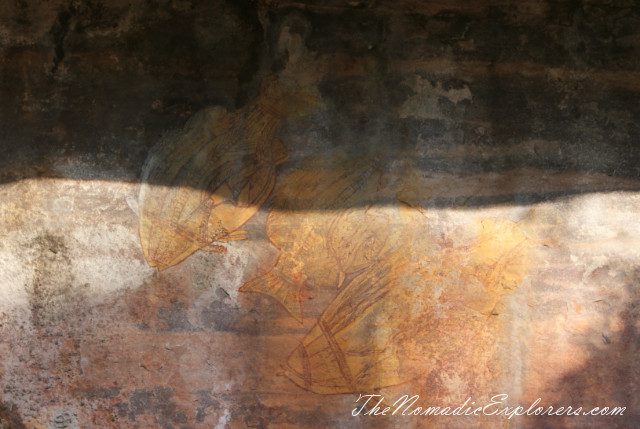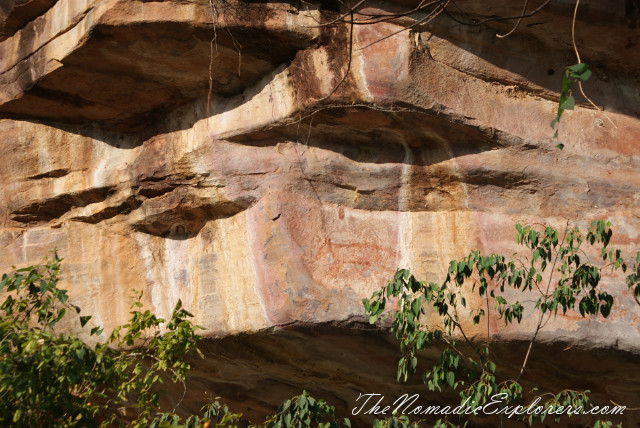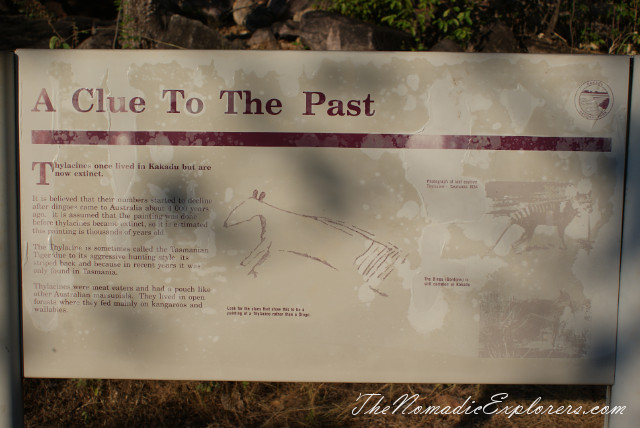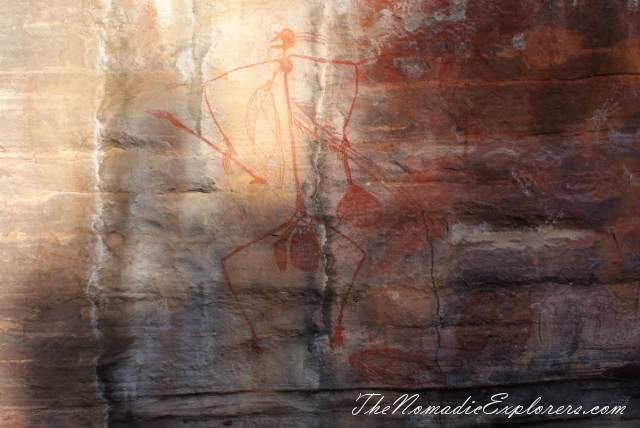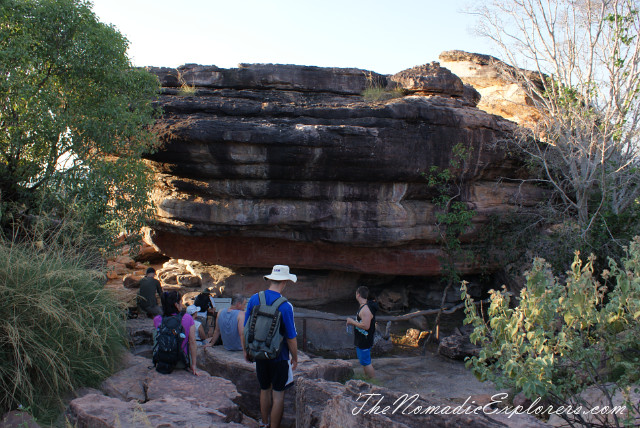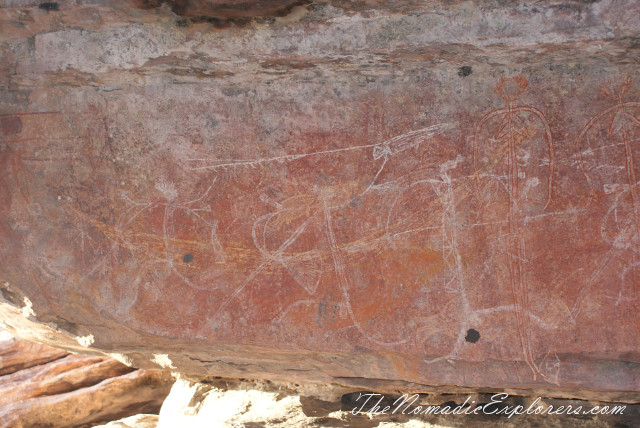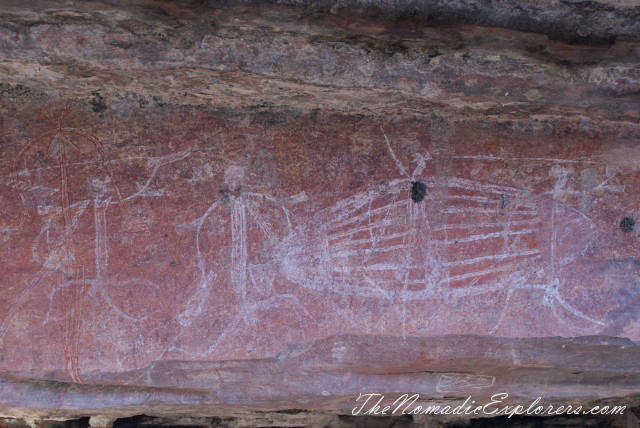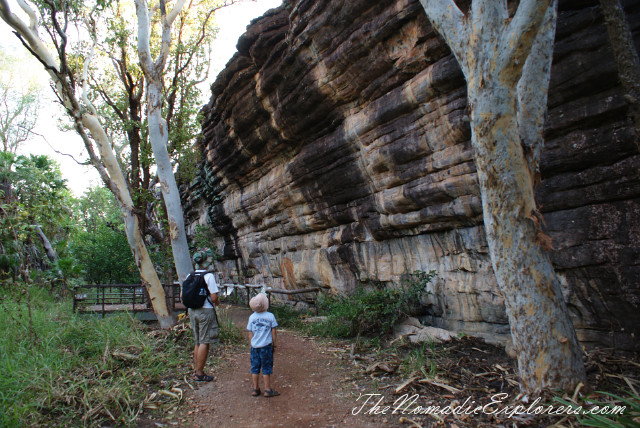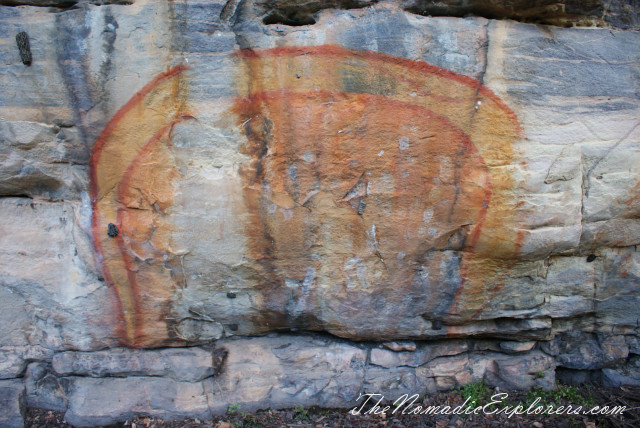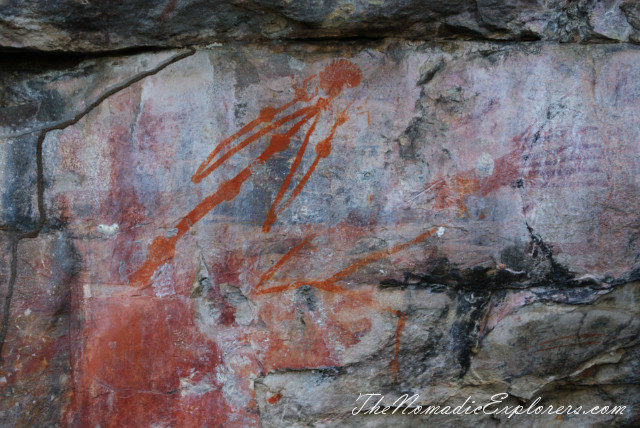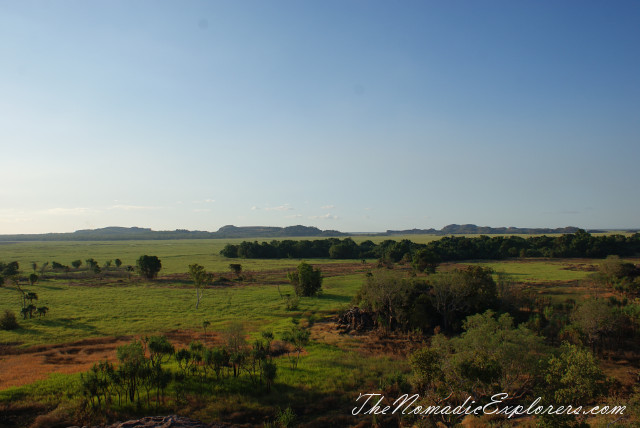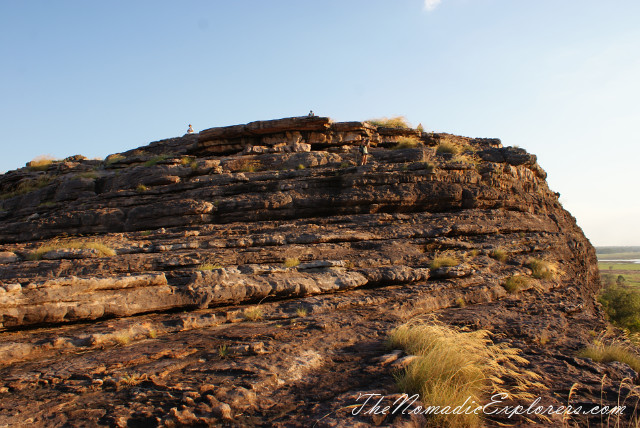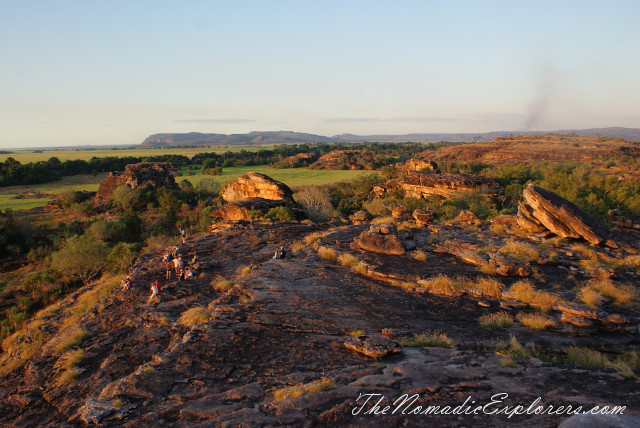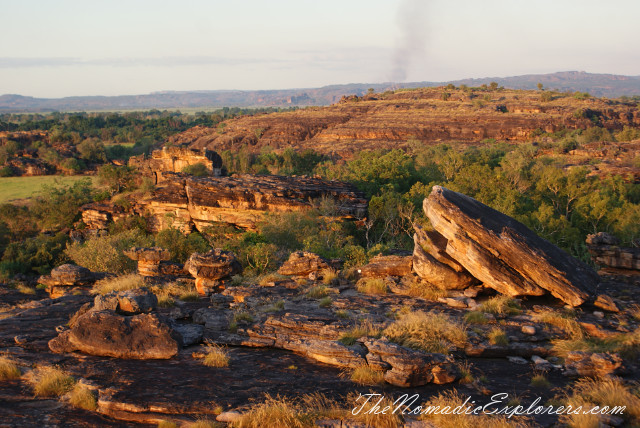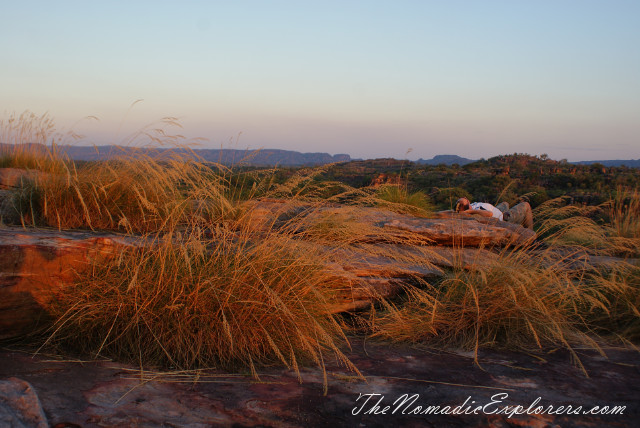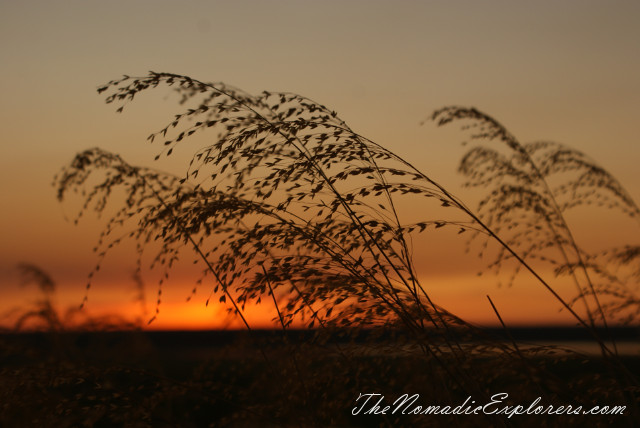Initially we had a plan to spend a night in Jabiru - a small city in the middle of Kakadu National Park, but after we checked the road status at Bowali Visitor Centre we found that the road to Ubirr is open (it was closed when we were in Darwin). We decided to go to Ubirr to watch the sunset and listen to a ranger talk.
The sunset at Nadab Lookout, Ubirr, was one of the most remarkable sunsets I’ve ever seen.
Ubirr rock art site is located about 40km north of Jabiru. I believe it is a must see place because of the abundance of well preserved Aboriginal rock art as well as the spectacular views of the Kakadu wetlands and the Arnhem Land rock escarpment.
There are three main art sites at Ubirr: the Main Gallery, the Namarrgarn Sisters and the Rainbow Serpent. The rock art site trails are all very well maintained and even wheel chair accessible.
If you looked at the pictures from Nanguluwur and Nourlangie, you might noticed that they were painted in different styles.
Kakadu National Park. Aboriginal Rock Paintings at Nanguluwur and Nourlangle/Anbangbang Gallery
The pictures at Ubirr are also different in different galleries. This is because Aboriginal art periods follow the climate and landscape changes that have occurred in the area.
Imagine that you have rock art from pre-estuarine period (50000 – 8000 years ago). This was during last ice age when earth much cooler. Sea levels were 150m lower than today and the coastline was 300km north of its present location and joined New Guinea. Kakadu was covered by low open woodland and shrub land typical of arid Australia today. Typical pictures were of prints of hands and objects like bunches of grass.
20000 years ago was the large naturalistic style period. Big animals, some now extinct.
15000 years ago you got simple figures with boomerangs.
The estuarine period was 8000 to 2000 years ago. The earth began to warm up 15000 years ago, sea levels slowly rose to present position about 6000 years ago. Mangrove swamps formed on floodplains and open forest woodland and savannah replaced the scrub. X-ray art started during this period – literally animals with x-ray features like stomachs, ribs etc.
Freshwater period started 2000 years ago and it goes to present. Sediment choked the swamps and floodplains developed. Along with that came invasion of freshwater animals, so you start to see paintings of magpie geese, humans with goose wing fans, terrapins etc.
Most of the paintings at Ubirr Rock are of the X-Ray style and usually of food such as fish and turtles. Most of the pictures here are from what’s known as the freshwater period, within the last 1500 years. The light was not the best one, but there are lots of food available, pictures of fish, waterfowl, mussels, wallabies etc.
This is barramundi. The upturned mouth, backbone (in the middle) and digestive tract outlined.
Of zoological interest is a painting of a Thylacine (Tasmanian Tiger) which is high on the rock face. The Thylacine was once found on the mainland, but has been extinct for somewhere between two and three thousand years. Can you see it?
This painting of Mabuyu reminds a story which warns against stealing:
The Nanarrgarn Sister Gallery:
Here is another piece of art that represents a story of two Aboriginal sisters who had the power to turn into crocodiles (see them in the right part of a photo):
Although the art was better at Anbangbang, this is older.
Kakadu National Park. Aboriginal Rock Paintings at Nanguluwur and Nourlangle/Anbangbang Gallery
These are the Namarrgarn sisters. When aboriginal children are told about the sisters they learn about crocodiles and their dangers. The Namarrgarn sisters used to play games near the mouth of the East Alligator River, where they would hide from each other by changing into crocodiles. One day one of the sisters suggested they turn into crocodiles so they could kill anyone they wanted to, no matter what clan. So they travelled to a freshwater spring near Point Farewell and changed into crocodiles. The palms that grow around the spring are derived from their teeth that they planted in the soil around the spring when they metamorphosed. As crocodiles, the Namarrgarn sisters always know where their victims are because of the large scales on the backs of their necks have extra sensory powers. The two bones that stick up either side of the top of the crocodiles head are said to be the Namarrgarn sisters.
The Namarrgarn Sisters gallery also tells a law story. The aboriginals have loads of stories relating to law, custom etc. These figures are of men with hunting and killing sticks. The story is that a young girl was out on her own and she caught a barramundi. Now she was at a certain stage where the fish was forbidden for her to eat. However, no one was a round and shame to waste a fish so she decided to eat it. Two fellas from another clan were passing and they caught her eating the forbidden fish and beat her up as punishment. The girl made her way back to her own clan. They were horrified and asked her what happened, so shamefully she told them. Now this clan was very upset with the two young men on two counts: 1) they thought the punishment that they had handed out to the girl was too severe and 2) it was not up to them to punish the girl. Result the clan went to war with the other clan. Young boys are told this story by older men pointing spears at them. The figure on the left is holding up a spear in a throwing stick. The guy on the right has a barbed spear going under his arm – a killer throw.
The Rainbow Serpent is one of the most powerful creation ancestors. There are many names and stories associated with the serpent across Australia, all of which show the significance and power of this mystical being within Aboriginal cultures.
The rainbow serpent, Garranga’rreli, travelled through this area in human form and painted her image on the rock here to remind people of her presence. She sleeps in Gunlom main plunge pool. Her stop here is part of a longer creation path (or dream line) that link together various places in Arnhem land. The rainbow serpent is one of the most powerful ancestors of creation time. Aboriginals are reminded of her in the winter months when rainbows appear in the sky. The rainbow serpent usually lives peacefully in waterways but can be upset by some noises, especially children crying. One day the rainbow serpent heard a child crying for sweet lily root. When night fell the child was given sour lily root, so it cried even more all night long. In the morning cold gusts of wind sprang up – signs that the rainbow serpent is near. The rainbow serpent rushed into the camp, trapped nearly everyone with its huge circled body and ate everyone. The moral of the story is: don’t let kids cry and everyone is responsible for children, not just the parents.
The bones of this person are swollen at some points. Said to be swollen by Miyamiya - a sickness that you get if you disturb the stones on a (unnamed) sacred site downstream on the East Alligator River. This is one of the reasons aboriginal people are so concerned about keeping sacred sites secret – they are dangerous to everyone. My thoughts are that some places near the uran mine are dangerous, so it is better to keep away from them.
After exploring the main galleries, it was time to move high onto the pinnacle Ubirr rock, overlooking the verdant green Nadab floodplain to the north.
The sunset was just beautiful, so peaceful....

We spent a night at Merl Campground (never-ever again!).
Where to stay: Darwin, Litchfield, Nitmiluk and Kakadu National Parks Campsites Review
Next morning we went to Darwin by Arnhem Nwy. If you would like to know what we have seen during that trip, read our next post.
